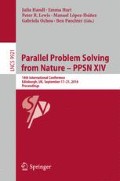Abstract
The community structure detection problem in weighted networks is tackled with a new approach based on game theory and extremal optimization, called Weighted Nash Extremal Optimization. This method approximates the Nash equilibria of a game in which nodes, as players, chose their community by maximizing their payoffs. After performing numerical experiments on synthetic networks, the new method is used to analyze functional connectivity networks of the brain in order to reveal possible connections between different brain regions. Results show that the proposed approach may be used to find biomedically relevant knowledge about brain functionality.
Access this chapter
Tax calculation will be finalised at checkout
Purchases are for personal use only
Notes
- 1.
Such projects include the BRAIN Initiative (http://www.braininitiative.nih.gov/, April, 2016) and the European Human Brain Project (https://www.humanbrainproject.eu/, April, 2016).
- 2.
By using the code available at https://sites.google.com/site/andrealancichinetti/software, accessed May, 2015.
- 3.
See http://fcon_1000.projects.nitrc.org/indi/ACPI/html/ for details.
- 4.
One ROI (Basal Ganglia 4) did not include meaningful measurement for any of the 126 subjects, therefore we ignored this ROI in the subsequent analysis.
- 5.
We note that in the brain research community, the phrases default mode network and salience network are used to refer to two specific sets of strongly interconnected regions of the brain. Therefore, the default mode network and the salience network are communities according to the terminology used throughout this paper.
References
Blondel, V.D., Guillaume, J.L., Lambiotte, R., Lefebvre, E.: Fast unfolding of communities in large networks. J. Stat. Mech.: Theory Exp. 2008(10), P10008 (2008)
Boettcher, S., Percus, A.: Nature’s way of optimizing. Artif. Intell. 119, 275–286 (2000)
Castellanos, F.X., Proal, E.: Large-scale brain systems in ADHD: beyond the prefrontal-striatal model. Trends Cogn. Sci. 16(1), 17–26 (2012)
Fortunato, S.: Community detection in graphs. Phys. Rep. 486, 75–174 (2010)
Lancichinetti, A., Fortunato, S.: Benchmarks for testing community detection algorithms on directed and weighted graphs with overlapping communities. Phys. Rev. E 80, 016118 (2009)
Lancichinetti, A., Fortunato, S., Kertész, J.: Detecting the overlapping and hierarchical community structure in complex networks. New J. Phys. 11(3), 033015 (2009)
Lancichinetti, A., Radicchi, F., Ramasco, J.J., Fortunato, S.: Finding statistically significant communities in networks. PloS One 6(4), e18961 (2011)
Leskovec, J., Krevl, A.: SNAP datasets: stanford large network dataset collection, June 2014. http://snap.stanford.edu/data
Lung, R.I., Dumitrescu, D.: Computing nash equilibria by means of evolutionary computation. Int. J. Comput. Commun. Control III(Suppl. issue), 364–368 (2008)
Lung, R., Suciu, M., Gasko, N.: Noisy extremal optimization. Soft Comput. 1–18 (2015). http://dx.doi.org/10.1007/s00500-015-1858-3
Ma, N., Liu, Y., Fu, X.M., Li, N., Wang, C.X., Zhang, H., Qian, R.B., Xu, H.S., Hu, X., Zhang, D.R.: Abnormal brain default-mode network functional connectivity in drug addicts. PloS One 6(1), e16560 (2011)
Newman, M.E.J.: Modularity and community structure in networks. Proc. Natl. Acad. Sci. 103(23), 8577–8582 (2006)
Roberts, G.M., Garavan, H.: Evidence of increased activation underlying cognitive control in ecstasy and cannabis users. Neuroimage 52(2), 429–435 (2010)
Rosvall, M., Bergstrom, C.T.: Maps of random walks on complex networks reveal community structure. Proc. Natl. Acad. Sci. 105(4), 1118–1123 (2008)
Shirer, W., Ryali, S., Rykhlevskaia, E., Menon, V., Greicius, M.: Decoding subject-driven cognitive states with whole-brain connectivity patterns. Cereb. Cortex 22(1), 158–165 (2012)
Suciu, M., Lung, R.I., Gaskó, N.: Mixing network extremal optimization for community structure detection. In: Ochoa, G., Chicano, F. (eds.) EvoCOP 2015. LNCS, vol. 9026, pp. 126–137. Springer, Heidelberg (2015)
Acknowledgment
K. Buza was supported by the grant of the National Research, Development and Innovation Office - NKFIH PD 111710 and the János Bolyai Research Scholarship of the Hungarian Academy of Sciences. This work was also supported by a grant of the Romanian National Authority for Scientific Research and Innovation, CNCS - UEFISCDI, project number PN-II-RU-TE-2014-4-2332.
Author information
Authors and Affiliations
Corresponding author
Editor information
Editors and Affiliations
Rights and permissions
Copyright information
© 2016 Springer International Publishing AG
About this paper
Cite this paper
Lung, R.I., Suciu, M., Meszlényi, R., Buza, K., Gaskó, N. (2016). Community Structure Detection for the Functional Connectivity Networks of the Brain. In: Handl, J., Hart, E., Lewis, P., López-Ibáñez, M., Ochoa, G., Paechter, B. (eds) Parallel Problem Solving from Nature – PPSN XIV. PPSN 2016. Lecture Notes in Computer Science(), vol 9921. Springer, Cham. https://doi.org/10.1007/978-3-319-45823-6_59
Download citation
DOI: https://doi.org/10.1007/978-3-319-45823-6_59
Published:
Publisher Name: Springer, Cham
Print ISBN: 978-3-319-45822-9
Online ISBN: 978-3-319-45823-6
eBook Packages: Computer ScienceComputer Science (R0)

